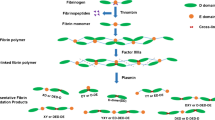Abstract
Although clinical requests for D-dimer are generally in the minority of assays in the routine clinical laboratory, they are an important aspect—especially if the laboratory supports an active emergency room and hematology service. Throughout the literature, D-dimer assays have been used for many purposes in the research setting; however it is generally the negative predictive value of the assay that is the most common piece of information being utilized from the standpoint of a clinician. Research or clinical needs will dictate the type of assay required—a qualitative, semiquantitative, or quantitative D-dimer assay may be appropriate for a particular purpose. Commonalities and differences between these assay types are outlined here, as well as universal concerns regarding standardization of D-dimer assay results.
Access this chapter
Tax calculation will be finalised at checkout
Purchases are for personal use only
Similar content being viewed by others
References
Hunt FA, Rylatt DB, Hart RA, Bundesen PG (1985) Serum crosslinked fibrin (XDP) and fibrinogen/fibrin degradation products (FDP) in disorders associated with activation of the coagulation of fibrinolytic systems. BJH 60(4):715–722
Adam SS, Key NS, Greenberg CS (2009) D-dimer antigen: current concepts and future prospects. Blood 113(13):2878–2887
Brown BA (1980) Coagulation. In: Hematology, 3rd edn. Lea & Febiger, Philadelphia, PA. p 115
Francis CW, Marder VJ (1994) Physiologic regulation and pathologic disorders of fibrinolysis. In: Colman RW, Hirsch J, Marder VJ (eds) Hemostasis and thrombosis: basic principles and clinical practice, 3rd edn. TB Lippincott Company, Philadelphia, PA, pp 1081–1083
Laffan M, Manning R (2006) Investigation of haemostasis. In: Lewis SM, Bain BJ, Bates I (eds) Dacie & Lewis practical haematology, 10th edn. Churchill Livingstone Elsevier, Edinburgh, p 386
Bockenstedt PL (2003) Laboratory methods in hemostasis. In: Loscalzo J, Schafer AI (eds) Thrombosis and hemorrhage. Lippincott Williams & Wilkins, Philadelphia, PA, pp 383–386
Ellman L, Carvalho A et al (1973) The Thrombo-Wellcotest as a screening test for disseminated intravascular coagulation. New Engl J Med 288:633
Dempfle CE (2006) D-Dimer assays: the current status and new assay technologies. Thromb Res 118:569–571
AMAX Accuclot D-Dimer product insert No. CRS116; revision 2003-02
Quantitative D-dimer for the exclusion of venous thromboembolic disease (2010) Proposed Guideline H59-P, Vol 30(No. 9)
Diagnostica Stago D-DI test package insert. REF 00454, 24552 02—Edition October 2003
Dempfle CE (2003) Evaluation of a new automated quantitative D-dimer, advanced D-dimer, in patients suspected of venous thromboembolism: a comment on correlation of D-dimer assays. Blood Coagul Fibrinol 14:313–317
Walker JB, Nesheim ME (1999) The molecular weights, mass distribution, chain composition, and structure of soluble fibrin degradation products released from fibrin clot perfused with plasmin. J Biol Chem 274:5201–5212
Pfitzner SA, Dempfle CE, Heene DL (1997) Fibrin detected in plasma of patients with disseminated intravascular coagulation by fibrin-specific antibodies consists primarily of high molecular weight factor XIIIa-crosslinked and plasmin-modified complexes partially containing fibrinopeptide A. Thromb Haemost 78:1067–1078
Dempfle CE, Zips S, Ergul H, Heene DL, and the FACT Study Group (2001) Evaluation of 23 quantitative D-dimer assays as basis for the development of D-dimer calibrators. Thromb Haemost 85:671–678
Hammouda W, Moroz LA (1987) False-positive reaction for fibrin degradation products due to a monoclonal (IgM lambda) cryoglobulin with warm-reactive antibody activity for rabbit IgG. Am J Med 82:1263–1268
Demplfle CE, Kontny F, Abildgaard U (1999) Predictive value of coagulation markers concerning clinical outcome 90 days after anterior myocardial infarction. Thromb Haemost 81(5):701–704
Galvani M, Ferrini D, Ottani F, Eisenberg PR (1999) Early risk stratification of unstable angina/non-Q myocardial infarction: biochemical markers of coronary thrombosis. Int J Cardiol 68(Suppl 1):S55–S61
Author information
Authors and Affiliations
Editor information
Editors and Affiliations
Rights and permissions
Copyright information
© 2013 Humana Press
About this protocol
Cite this protocol
Stang, L.J. (2013). D-Dimer and Fibrinogen/Fibrin Degradation Products. In: Monagle, P. (eds) Haemostasis. Methods in Molecular Biology, vol 992. Humana Press, Totowa, NJ. https://doi.org/10.1007/978-1-62703-339-8_34
Download citation
DOI: https://doi.org/10.1007/978-1-62703-339-8_34
Published:
Publisher Name: Humana Press, Totowa, NJ
Print ISBN: 978-1-62703-338-1
Online ISBN: 978-1-62703-339-8
eBook Packages: Springer Protocols




